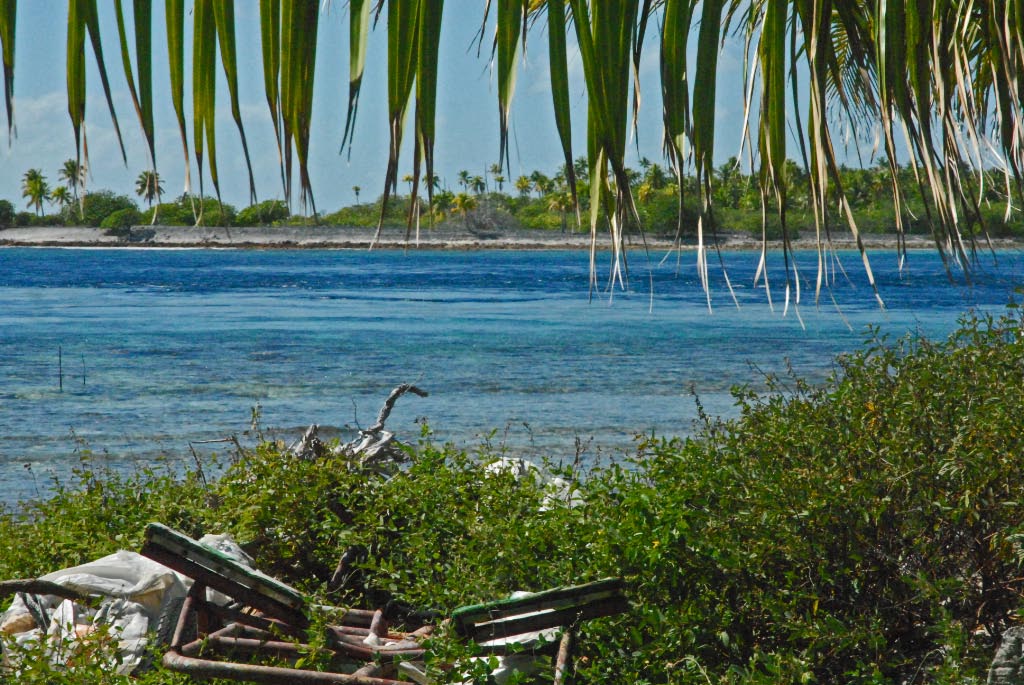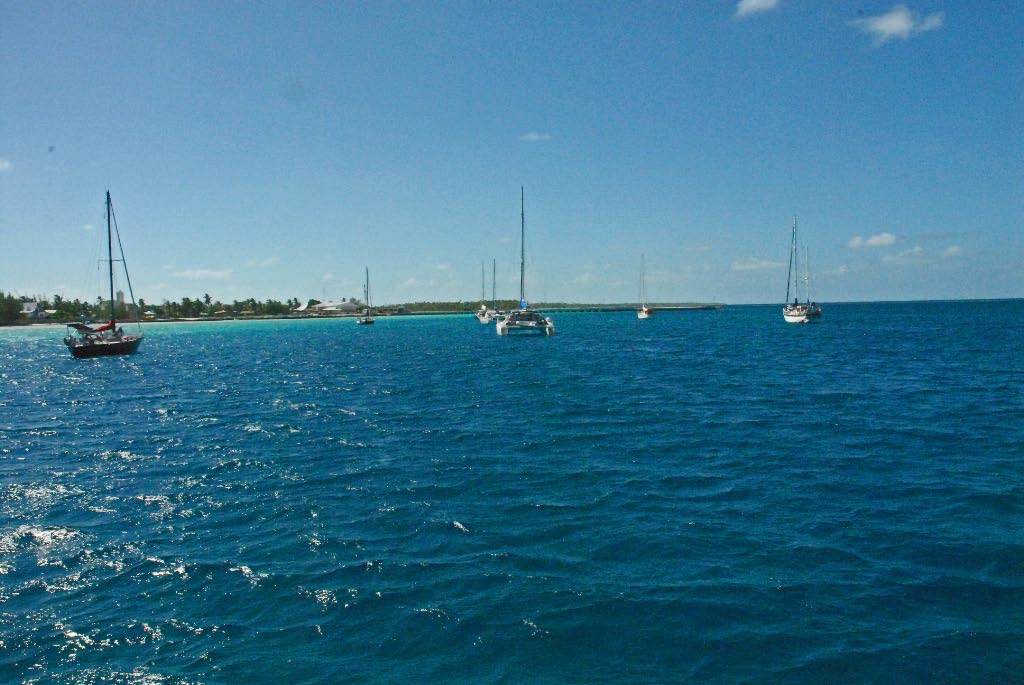When we left Seattle three years ago we joked about being “off the grid” as Wally and Dilbert would call it. No phones, no power bills and no cable TV or internet. It seemed like a nice idea at the time, like many ideas do. Reality is that with our sideband radio and modem we’ve never been away from email, and like many other cruisers when we get to an anchorage where there is wi-fi the prime anchoring spots are determined now by how good the signal is onboard the boat.
So when we discovered that our only remaining computer (one had died in Costa Rica) failed just as we were about to make one last check of the weather and pull up our hook for our passage from the Marquesas to the Tuamotus we were so sad. Sad to be totally unplugged and not to be able to write blogs or get email from family and friends along the way. But mostly unhappy about not having access to weather and tide information and being dependent on other friends out here to provide that for us. Did folks cruise years ago without computers and do fine using their barometers and knowledge of weather systems – sure they did. But we’ve really become accustomed to the latest and greatest forecast information we’ve been able to get at the click of a button.
So for now I’m borrowing a computer from Brit and will hopefully have my brother Tony ship a new one down to Papeete. And hopefully we can recover the hard drive from my old machine and get our address book back (if we regularly correspond with you and you don’t hear from us please drop us a note so I have your email address again). Anyway, back to the sailing tales.
The passage from the Marquesas to the Tuamotus basically sucked. There’s been some sort of a small convergence zone in that area for a couple of weeks and we had constant squalls and rain. We had waited in the Marquesas for some big winds to pass and sure enough the first night out we had no wind and motored for 15 hours. When the wind filled in it was from the right direction and reasonably strong, but every few hours we would pass through a rainsquall, which meant it would change directions and pipe up to 30 knots or so. We spent a lot of time furling and unfurling the jib. And as romantic as 15 knot beam winds sound when you’re home in Puget Sound (we never get to sail with beam winds there), in the Pacific Ocean they’re a pain in the ass because you have huge seas right on your beam that splash you constantly.
We were getting ready for our last night out and changed our destination to Makemo where Brit & Axel were because there was internet and we could borrow their computer and start making arrangements to get ours replaced. Also there was a store and a dive shop. The pass entrance at Makemo is a tough one because there is a 6-8 knot current from the huge lagoon through a small pass. We slowed down to arrive at daybreak and low tide, and found standing waves in the pass caused by the outgoing current bumping into the waves from the big winds (there was 25 knots of wind at the time). We waited until about 10 minutes after low tide hoping the current would ease and snuck in on the left side of the pass out of the standing waves with about 3.5-4 knots of current against us. Since our little boat only makes 5-6 knots we had little forward momentum, but finally were through and in safely.

The weather soon settled and we were inside a beautiful lagoon with crystal clear water and lots of coral and reef fishes. Brit & Axel arranged for the local dive shop to take us diving the next day so we could make our first drift dive through the pass with an experienced guide. Drift diving is basically being carried along by the current, which from what we had seen the day before sounded pretty intense. But the next day all the standing waves were gone and we went out as the end of the incoming tide was entering the lagoon. The coral outside the pass was as prolific and healthy as Rob had seen in the Red Sea years ago. The drift through the pass was exhilarating. The current was about 3-4 knots and it felt like we were literally flying along the reef.
The next day we decided to head north to the next atoll, which was 75 miles away. That’s too far to get during daylight so we left Makemo on a high slack tide at 5:00 pm, hoping to arrive at Tahanea in time for another slack tide at daybreak. The sailing was exceptional with a nearly full moon and beam winds without huge beam seas this time. But the wind kept clocking to the northwest all night. By the time we reached Tahanea before daybreak the clouds had packed in and the winds had built to 25 and we were sailing though massive storm cells with big winds and huge rains. Well crap, here we go again. And sure enough we missed the opportunity to get inside the pass at high tide because once again there were 6′ standing waves. We think the lagoon had filled up from the big winds pushing surf over the reef and the outgoing tide was much stronger than usual. So we had to wait outside for 5 hours in huge seas and wind and rain for the next slack tide. We couldn’t anchor or drift because the seas were so huge, so we motored around for 5 hours. In retrospect, we should have just hove to, which is a maneuver where you backwind your jib and essentially “park” the boat. But we had no sails up in the squalls and were on a lee shore. That meant we would have had to go offshore and then work our way back, and we kept thinking we could get through the pass “next time around”.
the big winds pushing surf over the reef and the outgoing tide was much stronger than usual. So we had to wait outside for 5 hours in huge seas and wind and rain for the next slack tide. We couldn’t anchor or drift because the seas were so huge, so we motored around for 5 hours. In retrospect, we should have just hove to, which is a maneuver where you backwind your jib and essentially “park” the boat. But we had no sails up in the squalls and were on a lee shore. That meant we would have had to go offshore and then work our way back, and we kept thinking we could get through the pass “next time around”.
Finally it was about 10 minutes to low tide and the standing waves were only on the right side of the pass. We could see upwind from us that some huge rain squalls were headed our way pretty quick, so we decided to make a run for it before we got blasted with what might be 30 knots of wind. We snuck in again on the left side with 2.5 knots of current against us and were so happy when we got the hook down in the anchorage inside the lagoon where we are now. Unfortunately this weather system is slow getting by us and we’re pitching about pretty good in here this morning. But the wind has turned more westerly which means the system is slowly moving away.
Once the weather settles we’ll try another drift dive through the pass here. There is no town or dive shop at this atoll, so we’ll take turns tending the dinghys with Hello World like we did at Cocos. But given that there are 3′ seas here inside the lagoon today, that likely won’t happen until tomorrow. Today I’ll get caught up on email and weather forecasts and figure out how to get a new computer shipped in.
Teresa